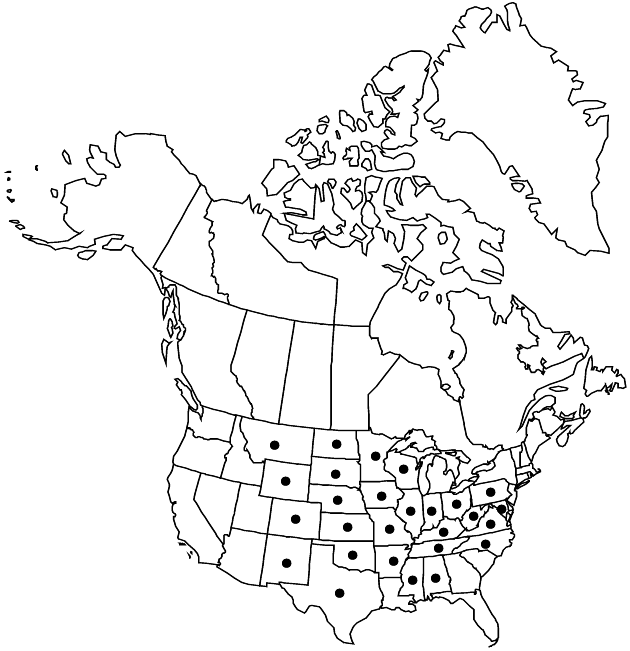Difference between revisions of "Symphyotrichum oblongifolium"
Phytologia 77: 287. 1995.
FNA>Volume Importer |
FNA>Volume Importer |
Revision as of 18:40, 24 September 2019
Perennials, 10–80(–100) cm, colonial; with thick, woody, short-branched caudices, sometimes ± cormoid, and thin, woody rhizomes. Stems 1–10+, ascending to erect or decumbent, light to dark brown, proximally glabrous, distally hispiduloso-hirsute or hirtellous, stipitate-glandular. Leaves (yellowish to dark green) thin, margins entire; basal sometimes persistent, sessile, blades (3-nerved) oblanceolate to spatulate, 20–50(–70) × 5–15 mm, margins entire (remotely serrate), coarsely ciliate, apices rounded, short-mucronate, faces usually hirsute, rarely glabrous, often also stipitate-glandular; proximal cauline sessile (often with clusters of smaller leaves in axils), blades oblong or linear-lanceolate, (15–)30–100 × 5–15(–20) mm, bases rounded or slightly clasping, margins scabrellous, apices acute to obtuse, spinulose-mucronate, abaxial faces scabrous, often stipitate-glandular, adaxial hirsute; distal sessile, blades lanceolate to oblong, 20–80 × 2–10(–20) mm, greatly reduced distally, bases cuneate to subclasping, margins ciliate, stipitate-glandular, apices acute to obtuse, white-mucronate, faces moderately strigose, moderately to densely stipitate-glandular. Heads in ample, corymbiform to diffusely paniculiform arrays, branches initially patent, then ascending (often from proximal nodes). Peduncles 0.5–5 cm, hispid, stipitate-glandular, bracts dense, spreading or squarrose (rarely ascending), linear to narrowly oblong, 3–8 mm, grading into phyllaries, spinulose, short-strigose. Involucres campanulate, (5–)7–9 mm. Phyllaries in 4–5(–6) series, outer oblanceolate, mid linear-lanceolate, inner linear, usually unequal, sometimes subequal, bases ± indurate, margins hyaline, scarious, erose, ciliate or ciliolate and/or stipitate-glandular, green zones often broadly foliaceous (outer), green in distal 1/3–1/2 (mid), apices spreading to reflexed (outer), acute, mid long-acuminate, faces moderately hairy, stipitate-glandular. Ray florets (10–)25–35; corollas light to dark rose-purple, lavender to deep purple, laminae 9–13(–15) × 1–2 mm. Disc florets (25–)30–40(–50); corollas yellow turning brown or reddish purple, 4.5–5.5(–6) mm, tubes 1/2 the funnelform to nearly tubular throats, lobes triangular, 0.4–0.7 mm. Cypselae dull purple or brown (nerves stramineous), obovoid, slightly falcate, not compressed, 2–2.5 mm, 7–10-nerved, faces sparsely strigillose or sericeous; pappi tawny (barb tips sometimes rose-tinged), 3.5–6 mm. 2n = 10, 20.
Phenology: Flowering Aug–Nov.
Habitat: Open, dry, rocky, sandy, gravelly, or shaly soils, limestone glades and outcrops, sandstone or calcareous cliffs, open-wooded bluffs, prairies, pastures, dunes, roadsides
Elevation: 100–1500+ m
Distribution

Ala., Ark., Colo., Ill., Ind., Iowa, Kans., Ky., Md., Minn., Miss., Mo., Mont., Nebr., N.Mex., N.C., N.Dak., Ohio, Okla., Pa., S.Dak., Tenn., Tex., Va., W.Va., Wis., Wyo., Mexico (Coahuila).
Discussion
Symphyotrichum oblongifolium varies greatly in leaf size and shape, the extremes of which have been the bases for varieties that are not distinct but merely represent the ends of a continuum of variation. The species is similar to S. ×amethystinum (S. ericoides × S. novae-angliae), but the latter has more hairy stems and leaves, and eglandular phyllaries. A leafy cultivar of the species is offered in the horticulture trade. A form with pink rays, merely a population variation, has been recognized as distinct from the more purple typical form: Aster oblongifolius forma roseoligulatus Shinners. Symphyotrichum batesii (Rydberg) G. L. Nesom (syn. Aster batesii Rydberg), reported from Nebraska, is the intersectional hybrid of this species with S. ericoides var. ericoides.
Selected References
None.